Spring here is at first so wary,
And then so spare that even the birds act like strangers,
Trying out the strange air with a hesitant chirp or two,
And then subsiding. But the season intensifies by degrees,
Imperceptibly, while the colors deepen out of memory,
The flowers bloom and the thick leaves gleam in the sunlight . . .
—from “The Late Wisconsin Spring” by John Koethe
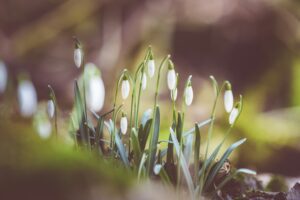
Human beings have celebrated festivals throughout all time, and in worldwide societies. The nature of these festive rituals was seasonal or spiritual, but most often both aspects melded together in a cohesive whole. These primordial observances were born of humanity’s inherent understanding of the unity of matter and spirit. For instance, they celebrated not only the joy and abundance of the harvest, but also honored the Spirit that animated the soil and waters, the seed and corn. Although current secular culture has created celebrations around sports, historic events, and other temporal happenings, many of our beloved festivals retain this seasonal and spiritual dimension.
 It is through our adult consciousness ~ our perception of the unity of cosmic and telluric forces ~ that we can infuse a simple festival with a sense of the sacred. Through attentive awareness we can bridge Spirit and Earth. Each festival will have its own rhythms and rituals, depending upon the time of year and therefore the mood of the activities. A spring fete among the flowers is a very different mood from that of a festive midwinter eve by the fire.
It is through our adult consciousness ~ our perception of the unity of cosmic and telluric forces ~ that we can infuse a simple festival with a sense of the sacred. Through attentive awareness we can bridge Spirit and Earth. Each festival will have its own rhythms and rituals, depending upon the time of year and therefore the mood of the activities. A spring fete among the flowers is a very different mood from that of a festive midwinter eve by the fire.
A festival, which is fully engaged with and dependent upon the unique aspects of a specific time and place, can also become a pole of remembrance toward the Divine. It can unite the boundlessness of Spirit with the eternally cycling here and now. It can unite past and present, as well as look toward the future. You might ask, “But how on earth can this happen amid the holiday hubbub?” In each festival, I find that a moment always presents itself when time stops for a little glimmer. I can look back down a long corridor of memories, down a golden chain of years past as we have gathered together in this way. I can also look forward along this golden chain to a time I will no longer be here in the flesh, but my spirit will live on in those whom I love. The largeness of this view invokes for me the large-vision of nesting circles of love. Our conscious remembrance of unity opens the floodgates, uniting the seen and unseen worlds. As we engage in this simple act of remembrance, we pass the torch to future generations.
We can think of ritual as “the physical manifestation of meaning,” keeping in mind how deeply meaningful rhythm and ritual are for young children. When we explore the neurological necessity of movement, we understand the nature of rhythm and how it affects the child’s entire neurobiology. Graceful, rhythmic movement stimulates the quiescent system of the brain, bringing a sense of harmony and wellbeing. Engaging in these graceful rhythms with others brings the group into harmonious resonance.
“But I don’t feel particularly graceful,” you may be thinking. Smile, sigh, and enter as a young
child would, with innocence and joy. Whether you are rhythmically sweeping the floor with a child, or singing in a Saturday afternoon choir rehearsal, it is our joined rhythmic movements that unite us. I believe this is why song and music are always intrinsic parts of festival celebrations the world over. Singing winter songs on a candlelit evening with other like-minded friends can “blur the edges of the brain’s sense of self, opening the door to unitary states.” Studies show us that throughout time, the world over, ritual has been designed to relieve humans of the shadow side of self-awareness: feelings of isolation. Awareness of self can be a double- edged sword. Celebration of festivals moves the balance toward a nuanced knowledge of self, held within the embrace of community.
The resonant states created by ritual lift individuals out of this isolation and embed us in something larger than ourselves. Experiencing these healing, unitive states together as a family or school class, and with those other beloveds who occupy our “field of love,” creates bonds that are written into our bloodstream and carried in the rhythm of our footsteps.
The Festive Table
From my kindergarten journal:
What a pleasure it is, in the twenty-first century, to set a large table with glassware, bowls andbaskets of whole foods. It is morning and the table is ready, waiting in anticipation of the children. This table groans not only with food, but also with children’s laughter, shared communion and culture being passed on, bowl by bowl.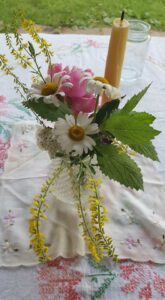
The table is a living symbol of gathering, sharing, celebration and communion. Let’s consider how to prepare the festival table in easy, elegant and natural ways. The simple act of laying a beautiful cloth over the table can completely transform the entire room, creating a mood of anticipation. Shaking out the tablecloth and placing it just so says, “Let the magic commence.” You may want to have a special tablecloth for each seasonal festival. This way, the cloth itself helps to define the occasion. Go to the fabric store and buy a length of cloth to fit your table. Look for seasonal colors in quiet patterns, which will hide stains and wash easily. Hem the two ends and, voilà!—a tablecloth. In our family we had a cloth with golden autumn leaves for fall, green sprays of pine boughs for winter, and a vibrant spring floral for spring. I didn’t choose fabric from the children’s section, as these designs tend to be “cutesy.” Instead, I chose fabrics of my own taste. Because our festive tablecloths and decorations were of very different colors and designs, I chose a plain white embossed china that would be good on any background. On top of the seasonal cloth, you can place a simple, elegant centerpiece, perhaps a grapevine wreath decorated with “treasures” from your daily walks. You could buy seasonally colored candles to go with the wreath, and include the magic of candlelight in your celebration.
The beautiful cloth and simple china, the natural “hand-gathered” centerpiece decorations, candles, dishes and platters full of festive foods—for your young child, these physical substances are the essence of the festival. In time your child will begin to form concepts: gathering, sharing, celebration, communion. But for now, the meaning lies in the actuality of the things themselves. So let us take care and delight in preparing them well.
A Spring Festival
The surging joy of springtime, with its dancing, laughing energy, makes it nearly impossible to talk about; it makes us want to sing! Each new blossom is a celebration in its own right. So, how to capture this delicious, raucous delight in a festival?
Eggs are a perfect symbol of this feast of Life. Each one contains a sun radiating within, the yellow disk of its orb, the white rays shining. Although our children may not entirely love the flavor of the egg, this is no reason to abandon it. In my family and classroom we dyed, decorated and hid real hard-boiled eggs. I felt in this way the archetypal symbol of the egg remained intact. No candy-filled plastic eggs in the Spring-Baskets, please. Rather, let’s think of knitted bunnies and colorful polished stones.
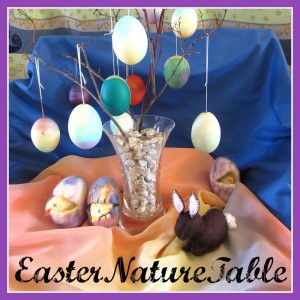 A few days or a week before the festival, try making an egg tree with your child or class. On a walk in the woods or the back yard, look for a sturdy small branch, perhaps with buds just forming on it, and with a pleasing line. Perhaps you will find one that looks like a miniature tree. Back inside, anchor the branch in soft clay and place it in the bottom of a large clay saucer, the kind that fits under planting pots. Now fill the saucer with potting soil, and you have a miniature scene of a bare winter tree, standing on the naked earth. Over the next days, you can begin to build up this scene.
A few days or a week before the festival, try making an egg tree with your child or class. On a walk in the woods or the back yard, look for a sturdy small branch, perhaps with buds just forming on it, and with a pleasing line. Perhaps you will find one that looks like a miniature tree. Back inside, anchor the branch in soft clay and place it in the bottom of a large clay saucer, the kind that fits under planting pots. Now fill the saucer with potting soil, and you have a miniature scene of a bare winter tree, standing on the naked earth. Over the next days, you can begin to build up this scene.
At the local natural foods store, look for wheat berries, the seeds of the wheat. Set some of them aside to be baked into a sweet festival bread. Take about one cup of berries and soak them overnight, and perhaps the next day, also. Rinse them every twelve hours. When you see a small white root popping out, it is time to plant. Rinse once more, then spread the seeds thickly over the potting soil and cover with a thin layer of soil. You can water the seeds with a plant sprayer. If you water them too much, they will mold, so be careful. A plant sprayer also allows your child to water away happily, with less likelihood of flooding. Again, a clay pot, unlike plastic, will help to absorb excess moisture.
In just a couple of days you should see green tips pushing up, and the roots beginning to grow. This is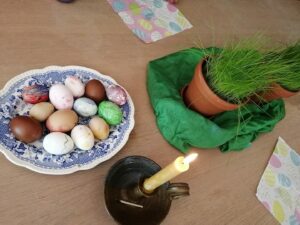 such an exciting moment for the young child! Wheat grows so fast that each day there is a noticeable difference. Because it is wheat, you can “mow” the grass with scissors and nibble on it with the children. It has a sweet green taste, and is actually full of nutrition. You can add to the festive scene with modeled beeswax leaves, daffodils and birds nesting in the branches.
such an exciting moment for the young child! Wheat grows so fast that each day there is a noticeable difference. Because it is wheat, you can “mow” the grass with scissors and nibble on it with the children. It has a sweet green taste, and is actually full of nutrition. You can add to the festive scene with modeled beeswax leaves, daffodils and birds nesting in the branches.
Now, as the festival day draws near, you can make “blown” eggs to hang on the branches of the tree. With a strong needle, make a large hole in the bottom of a raw egg, and a smaller hole in the top. With older children, a small hole at each end works fine, but for little ones, we need slightly bigger holes. Place your mouth over the small hole, with lips making a seal, and blow the contents of the egg into a bowl well placed beneath the operation. Small children can help, and by the time they are almost five years old they may actually be able to blow the whole egg out by themself! Keep the bowl of eggs for a special holiday egg custard. You can dye the eggshells (very carefully) with food color. Then loop a ribbon and push the ends carefully into the big hole. With a toothpick, you should be able to glue it to the inside of the shell. This makes a colorful hanger. Many craft stores sell small colored wooden eggs with hangers. When hung together with the dyed blown eggs, the variety of sizes is wonderful to behold, shining on the tree in morning light. With the vigorous growth of green grass below, you have transformed a bare winter scene into a corner bursting with life. If your branch had buds on it, with the warmth of being indoors its leaves may even begin to unfold, or blossoms may appear.
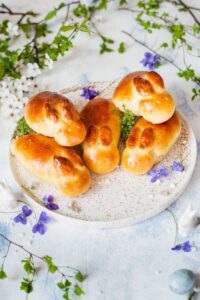 The day before the festival, bake a simple whole wheat bread to shape into “bread bunnies” and serve with autumn’s festive apple butter. Or you can try baking an egg basket: make the dough into thin braids, shape a length of these braids into a small bowl, decorate with the wheat berries, place a whole uncooked egg (in its shell) in the center, and put a little braided dough handle over the top. Bake as usual, and you will have made a hard-cooked egg in a braided basket!
The day before the festival, bake a simple whole wheat bread to shape into “bread bunnies” and serve with autumn’s festive apple butter. Or you can try baking an egg basket: make the dough into thin braids, shape a length of these braids into a small bowl, decorate with the wheat berries, place a whole uncooked egg (in its shell) in the center, and put a little braided dough handle over the top. Bake as usual, and you will have made a hard-cooked egg in a braided basket!
Stovetop egg custard is a delicious and nutritious treat that you can make for snack, after the egg hunt on the festival morning. In a double boiler, whisk one cup of whole milk for every two eggs. Add honey or sugar to taste, and a little nutmeg or cinnamon. Stirring constantly, in a few minutes the mixture should begin to thicken. Continue to stir as it slowly cooks, until it mounds up in a little hill in your spoon. Cool, and refrigerate, if you won’t eat it immediately. Serve it with the homemade sweet bread full of wheat berries. There are deviled eggs and egg salads in the near future, if you have featured real eggs in your celebration. In this way, the festival continues to live and to nourish us.
Stories for a spring festival can image transformation. For a young child, the story of the lowly caterpillar transforming into the majestic butterfly is perfect. An older child might need a stronger illustration, such as the excellent Native American transformation tale Jumping Mouse. Children’s literature is filled with images of transformation, and if you choose tales that speak to your own heart, your enthusiasm will carry a power of its own.
Festivals Bridge the Worlds
Festivals offer us moments outside of time, helping us to gaze back upon celebrations in years past and imagine forward toward years, lives, and loves to come. Before our eyes, in the present, we can see the past as well as the future. This wholeness shines into the eyes of those we love, gathered together around the festival table. Holding this wide breadth of time, growth, and love, we pass the torch to future generations.
Excerpted from Heaven on Earth By Sharifa Oppenheimer with permission of SteinerBooks
Visit her website Wild Graces
https://www.sharifaoppenheimer.org
and her Substack
Rewilding the Human Heart
https://sharifaoppenheimer.substack.com
